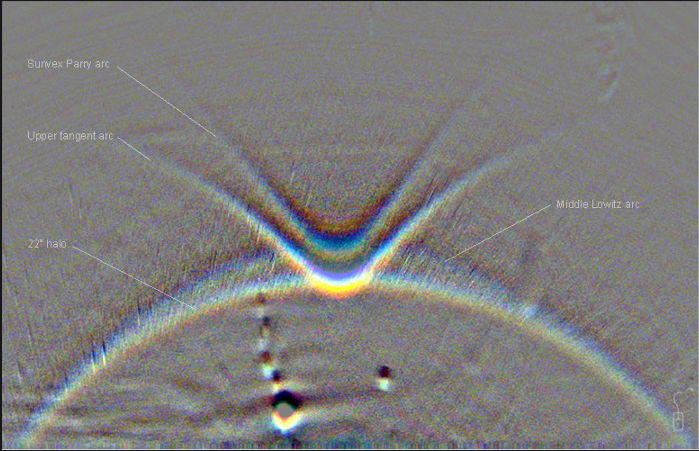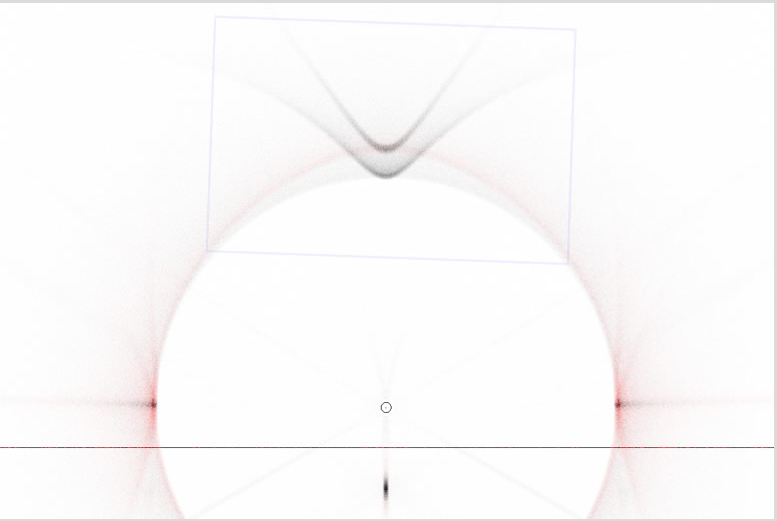Middle Lowitz Arc
Exploring the Middle Lowitz Arc and Its Unique Characteristics
The Middle Lowitz Arc is a fascinating atmospheric optical phenomenon that occurs under specific conditions. It is a rare combination of the Lowitz arc, sunvex Parry, upper tangent arc, and 22° halo. This unique display offers a captivating sight in the sky, showcasing a variety of arcs and halos. In this article, we will delve deeper into the Middle Lowitz Arc, its formation, and the factors that contribute to its appearance.
Understanding the Formation of the Middle Lowitz Arc
To comprehend the Middle Lowitz Arc, it is essential to understand the relative positions and shapes of the Parry and upper tangent arcs. These arcs fix the solar elevation at approximately 4°. At this particular sun height, the Middle Lowitz Arc curves upwards and over the sun, remaining tangential to a sunvex Parry arc. This distinct curvature and alignment create a visually striking phenomenon that captures the attention of observers.
Factors Influencing the Appearance of the Middle Lowitz Arc
Several factors contribute to the appearance of the Middle Lowitz Arc, making it a relatively rare sight to behold. One significant factor is the concentration of Lowitz-oriented plates. The figures obtained from HaloSim4 simulations illustrate that a relatively large concentration of these plates is necessary to produce the display. The scarcity of sightings can be partly attributed to this requirement.
Furthermore, variations in crystal concentrations across the sky also play a role in the appearance of the Middle Lowitz Arc. Different regions may have varying concentrations of crystals, leading to disparities in sightings. Additionally, the known transience of the Lowitz appearance further adds to its elusive nature.
The Influence of Crystal Orientation on the Middle Lowitz Arc
The orientation of crystals also contributes to the intensity and visibility of the Middle Lowitz Arc. Observations made by Gary Saunders suggest that semi-regular hexagonal Lowitz crystals enhance the intensity of the middle arc. These findings align with the research conducted by Riikonen et.al. However, it is important to consider other factors that may influence the appearance, such as the clustering of upper and lower Lowitz components around sundogs.
Analyzing HaloSim4 Simulation Data
HaloSim4 simulations provide valuable insights into the Middle Lowitz Arc phenomenon. The simulations utilize various crystal orientations to replicate the atmospheric conditions required for its formation. For example, the simulation used 38% Lowitz-oriented plates, 1% ordinarily oriented plates for the parhelia, 5% Parry-oriented columns, 15% singly oriented columns, and 41% randomly oriented columns. These data points shed light on the specific crystal configurations necessary for the Middle Lowitz Arc to manifest.
Enhancing Our Understanding Through Observations
To further our understanding of the Middle Lowitz Arc, observations play a crucial role. Gary Saunders' images offer valuable visual documentation of this unique atmospheric optical phenomenon. By studying these images and comparing them to other sightings, we can gain insights into the intricacies of the Middle Lowitz Arc and its variations.
In conclusion, the Middle Lowitz Arc is a captivating atmospheric optical display that combines various arcs and halos. Its formation relies on the relative positions and shapes of Parry and upper tangent arcs, as well as the concentration and orientation of Lowitz-oriented plates. While it remains a relatively rare sight, continued observations and simulations contribute to our understanding of this mesmerizing phenomenon. As we unravel the complexities of atmospheric optics, the Middle Lowitz Arc stands as a testament to the beauty and wonder of our natural world.



Middle Lowitz arc over the Atlantic Ocean. Imaged by Gary Saunders 12th September 2005 from the flight deck of an aircraft at 33,000ft.
A rare combination of Lowitz, sunvex Parry, upper tangent arc and 22° halo.
Mouse over the image for an enhanced view and halo key.
The relative positions and shapes of the Parry and upper tangent arcs fix the solar elevation at ~4°. At this sun height the middle Lowitz arc curves upwards and over the sun but it remains tangential to a sunvex Parry arc.
In the HaloSim4 simulation, the rectangle shows the area covered by the image. Arcs formed by classically oriented Lowitz plates appear in red.
The simulation used 38% Lowitz oriented plates, 1% ordinarily oriented plates to produce the parhelia, 5% Parry oriented columns, 15% singly oriented columns and 41% randomly oriented columns.
The figures illustrate the relatively large concentrations of Lowitz oriented plates that are necessary to produce a display and perhaps partly accounts for the paucity of sightings.
Upper and lower Lowitz components are clustered around the sundogs but they do not appear in several of Gary Saunder's images of the left hand parhelion. This could be taken as evidence for semi-regular hexagonal Lowitz crystals that enhance the intensity of the middle arc as suggested by Riikonen et.al. However, other factors such as the known transience of the Lowitz appearance in this display and variations in crystal concentrations across the sky could be responsible.
Note: this article has been automatically converted from the old site and may not appear as intended. You can find the original article here.
Reference Atmospheric Optics
If you use any of the definitions, information, or data presented on Atmospheric Optics, please copy the link or reference below to properly credit us as the reference source. Thank you!
-
<a href="https://atoptics.co.uk/blog/middle-lowitz-arc/">Middle Lowitz Arc</a>
-
"Middle Lowitz Arc". Atmospheric Optics. Accessed on November 26, 2024. https://atoptics.co.uk/blog/middle-lowitz-arc/.
-
"Middle Lowitz Arc". Atmospheric Optics, https://atoptics.co.uk/blog/middle-lowitz-arc/. Accessed 26 November, 2024
-
Middle Lowitz Arc. Atmospheric Optics. Retrieved from https://atoptics.co.uk/blog/middle-lowitz-arc/.